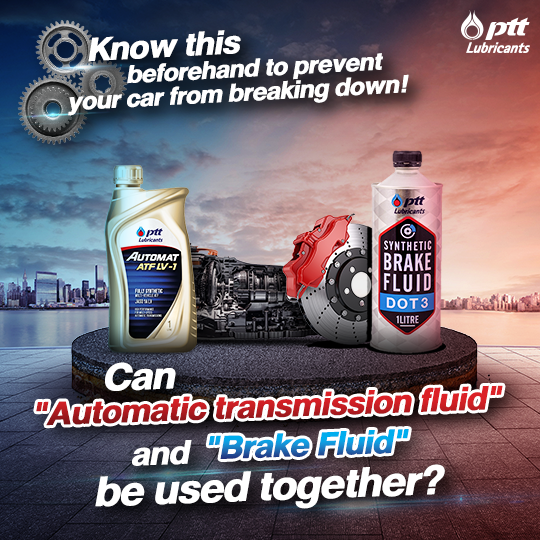
Are automatic transmission fluids and brake fluids really interchangeable?
Know this beforehand to prevent your car from breaking down!
Answers to the questions about lubricants and fluids used in cars, which many people may have been wondering about or have heard of: Can "Automatic transmission fluid" and "Brake Fluid" be used together or not? Since they are both liquid, they should be used interchangeably without any problem, shouldn’t they?
Today, with 'Technicians Say… by PTT Lubricants', we are going to solve the question in this matter for everyone!
Question: Can automatic transmission fluids and brake fluids be used interchangeably?
Technicians say:
Although both automatic transmission fluid and brake fluid are fluids that transmit power in a vehicle's system, they CANNOT be used interchangeably or substitutionally as the two types of oils/liquids are designed to have distinctly different properties. We, therefore, need to choose an exact and appropriate one for each system.
The differences between the two types of oils/liquids can be summarized as follows:
Automatic Transmission Fluid (ATF) is a transmission fluid for automatic transmissions used in passenger cars and many other vehicles. It serves primarily as a lubricant to protect gears and metal parts from wear by transmitting the power in a torque converter allowing the gear drive shaft to rotate. It is also used to create pressure to squeeze or loosen the clutch plates when changing gears or changing ratios. Therefore, as can be seen that the operation of the automatic transmission system is complex and multi-functional, it is important to choose a gear oil that is specific and meets the specifications specified by the vehicle manual for good gear performance and long service life. The automatic transmission fluid consists mainly of high quality paraffinic base oils (API Group II and/or III), which have low viscosity properties and high viscosity index, and is mixed with other important additives such as anti-wear additives, friction modifier, viscosity modifier and anti-foaming agents, etc. However, even when the automatic transmission fluid is designed to have viscosity for faster flow to control the clutch and reduce engine power loss, but “the viscosity of the automatic transmission fluid group is still higher than that of the brake fluid group” (DOT 3, DOT 4, DOT 4+, DOT 5 and DOT 5.1) Therefore, if we use automatic transmission fluid with the brake system (disc brakes and drum brakes), it will worsen braking performance and increase the risk of accidents as a result of the higher-than-normal viscosity of the fluid, making the transmission flow slower and more brake pressure may be required. It will also result in excessive pressure and heat build-up within the brake system, leading to damage to various components and oil leaks along the ducts.
Brake Fluid is a transmission fluid for brake systems (disc brakes and drum brakes) used in passenger cars and many other motor vehicles by acting as a medium to transmit hydraulic pressure from the brake master cylinder to the brake pistons allowing the brake pads and brake discs to contact and slow down the wheels until they eventually stop. The brake fluid that is commonly used in general is based on the FMVSS No.116 DOT 3 and DOT 4 standards, or what we know by the names of brake fluid DOT 3 and DOT 4. In addition, DOT 4+ and DOT 5.1 are also common in high-performance vehicles or braking systems that are exposed to continuous high heat. Brake fluid, however, is not actually classified as lubricating oils since it does not contain base oil as specified by API criterion. The brake fluid mainly consists of glycol ethers that are recognized by its exceptionally ultra-low viscosity, enabling the fluid to flow at negative temperatures and deliver rapid pressure to provide good braking performance. Furthermore, the glycol ethers have a sufficiently high boiling point temperature which is excellent in absorbing the heat generated in the braking system and helping prevent boils, bubbles and vapor lock. Higher boiling point brake fluids such as DOT 4, DOT 4+ and DOT 5.1, however, contain an additional proportion of Borate Ester. Therefore, you should choose to use brake fluid according to the specifications specified by the car manual and appropriate to the conditions of use.
In conclusion, “The viscosity of brake fluid is too low for automatic transmission. It also does not contain important additives” such as anti-wear additives and friction modifiers. Therefore, using the brake fluid with the gear system will result in poor gear shifting performance, gear jerk and poor acceleration. It can also lead to wear and serious damage to gear parts.
Now that you have learned all the information, be sure to choose a product that matches the type of use while changing the lubricant and fluid in the car in order to preserve the car and allow us to drive the car at its fullest potential. Also, don’t forget to study the standard and specification of the products that we are going to use to ensure they are suitable for our car models!